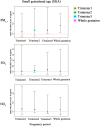Effect of ambient air pollution on premature SGA in Changzhou city, 2013-2016: a retrospective study
- PMID: 31174511
- PMCID: PMC6555963
- DOI: 10.1186/s12889-019-7055-z
Effect of ambient air pollution on premature SGA in Changzhou city, 2013-2016: a retrospective study
Abstract
Background: Air pollution is becoming an increased burden to the world. Previous studies have confirmed its effects on adverse birth outcomes, but few associated with premature small for gestational age (SGA). We report a retrospective cohort study conducted in Changzhou city to evaluate the association between air pollutants (PM2.5, SO2 and NO2) and premature SGA during pregnancy.
Methods: A total of 46,224 births were collected from January, 2013 to December, 2016, in Changzhou Maternity and Child Health Care Hospital, finally 2709 preterm births were admitted for study. Corresponding air monitoring data were collected from Changzhou Environmental Protection Agency. Generalized estimating equations were used to examine the association between these air pollutants and premature SGA controlling for individual covariates in single- and multi-pollutant models.
Results: We found that, in the third trimester, every 10 μg/m3 increments in PM2.5 concentration were associated with premature SGA (OR = 1.18, 95% CI: 1.03-2.83; OR = 1.37, 95% CI: 1.03-3.58) in two- and three-pollutants models. In the whole gestation, a 10 μg/m3 increment in PM2.5 concentration in two- and three-pollutant models were related to premature SGA (OR = 1.53, 95% CI: 1.38-2.47; OR = 1.73, 95% CI: 1.18-2.57). The OR (95% CI) of premature SGA were increasing across quintiles of PM2.5, SO2, NO2 concentrations during the whole gestation period adjusting for confounders (P for trend < 0.001).
Conclusions: These results indicated that pregnant women exposed to PM2.5, combined with other pollutants in the third trimester have a higher risk to deliver premature SGA babies, providing further evidence linking PM2.5 and pregnancy outcomes.
Keywords: Air pollution; Exposure windows; Premature SGA; Retrospective study.
Conflict of interest statement
The authors declare no conflict of interest.
Figures




Similar articles
-
Association between ambient air pollution exposure and infants small for gestational age in Huangshi, China: a cross-sectional study.Environ Sci Pollut Res Int. 2019 Nov;26(31):32029-32039. doi: 10.1007/s11356-019-06268-7. Epub 2019 Sep 6. Environ Sci Pollut Res Int. 2019. PMID: 31493084 Free PMC article.
-
Associations between maternal exposure to air pollution and birth outcomes: a retrospective cohort study in Taizhou, China.Environ Sci Pollut Res Int. 2018 Aug;25(22):21927-21936. doi: 10.1007/s11356-018-1944-z. Epub 2018 May 24. Environ Sci Pollut Res Int. 2018. PMID: 29797193
-
The Association between Preterm Birth and Ambient Air Pollution Exposure in Shiyan, China, 2015-2017.Int J Environ Res Public Health. 2021 Apr 19;18(8):4326. doi: 10.3390/ijerph18084326. Int J Environ Res Public Health. 2021. PMID: 33921784 Free PMC article.
-
Ambient air pollution and pregnancy outcomes: A comprehensive review and identification of environmental public health challenges.Environ Res. 2018 Nov;167:144-159. doi: 10.1016/j.envres.2018.07.008. Epub 2018 Jul 5. Environ Res. 2018. PMID: 30014896 Review.
-
Air pollution and pregnancy outcomes based on exposure evaluation using a land use regression model: A systematic review.Taiwan J Obstet Gynecol. 2021 Mar;60(2):193-215. doi: 10.1016/j.tjog.2021.01.004. Taiwan J Obstet Gynecol. 2021. PMID: 33678317
Cited by
-
Synergistic or Antagonistic Health Effects of Long- and Short-Term Exposure to Ambient NO2 and PM2.5: A Review.Int J Environ Res Public Health. 2022 Oct 28;19(21):14079. doi: 10.3390/ijerph192114079. Int J Environ Res Public Health. 2022. PMID: 36360958 Free PMC article. Review.
-
Insights into Prevention of Health Complications in Small for Gestational Age (SGA) Births in Relation to Maternal Characteristics: A Narrative Review.J Clin Med. 2023 Jan 9;12(2):531. doi: 10.3390/jcm12020531. J Clin Med. 2023. PMID: 36675464 Free PMC article. Review.
-
The concentration of major air pollutants during the movement control order due to the COVID-19 pandemic in the Klang Valley, Malaysia.Sustain Cities Soc. 2021 Mar;66:102660. doi: 10.1016/j.scs.2020.102660. Epub 2020 Dec 15. Sustain Cities Soc. 2021. PMID: 33520606 Free PMC article.
-
Antagonism of interleukin 17 protects chronic obstructive pulmonary disease rat lungs from adverse effects of environmental PM2.5.Am J Transl Res. 2020 Sep 15;12(9):5808-5817. eCollection 2020. Am J Transl Res. 2020. PMID: 33042460 Free PMC article.
References
-
- Xia Xiaolin, Zhang An, Liang Shi, Qi Qingwen, Jiang Lili, Ye Yanjun. The Association between Air Pollution and Population Health Risk for Respiratory Infection: A Case Study of Shenzhen, China. International Journal of Environmental Research and Public Health. 2017;14(9):950. doi: 10.3390/ijerph14090950. - DOI - PMC - PubMed
-
- Lin H, Guo Y, Kowal P, Airhihenbuwa CO, Di Q, Zheng Y, Zhao X, Vaughn MG, Howard S, Schootman M, et al. Exposure to air pollution and tobacco smoking and their combined effects on depression in six low- and middle-income countries. Br J Psychiatry. 2017;211(3):157–162. doi: 10.1192/bjp.bp.117.202325. - DOI - PMC - PubMed
-
- Mueller N, Rojas-Rueda D, Basagana X, Cirach M, Cole-Hunter T, Dadvand P, Donaire-Gonzalez D, Foraster M, Gascon M, Martinez D, et al. Health impacts related to urban and transport planning: a burden of disease assessment. Environ Int. 2017;107:243–257. doi: 10.1016/j.envint.2017.07.020. - DOI - PubMed
MeSH terms
Substances
Grants and funding
LinkOut - more resources
Full Text Sources
Medical

